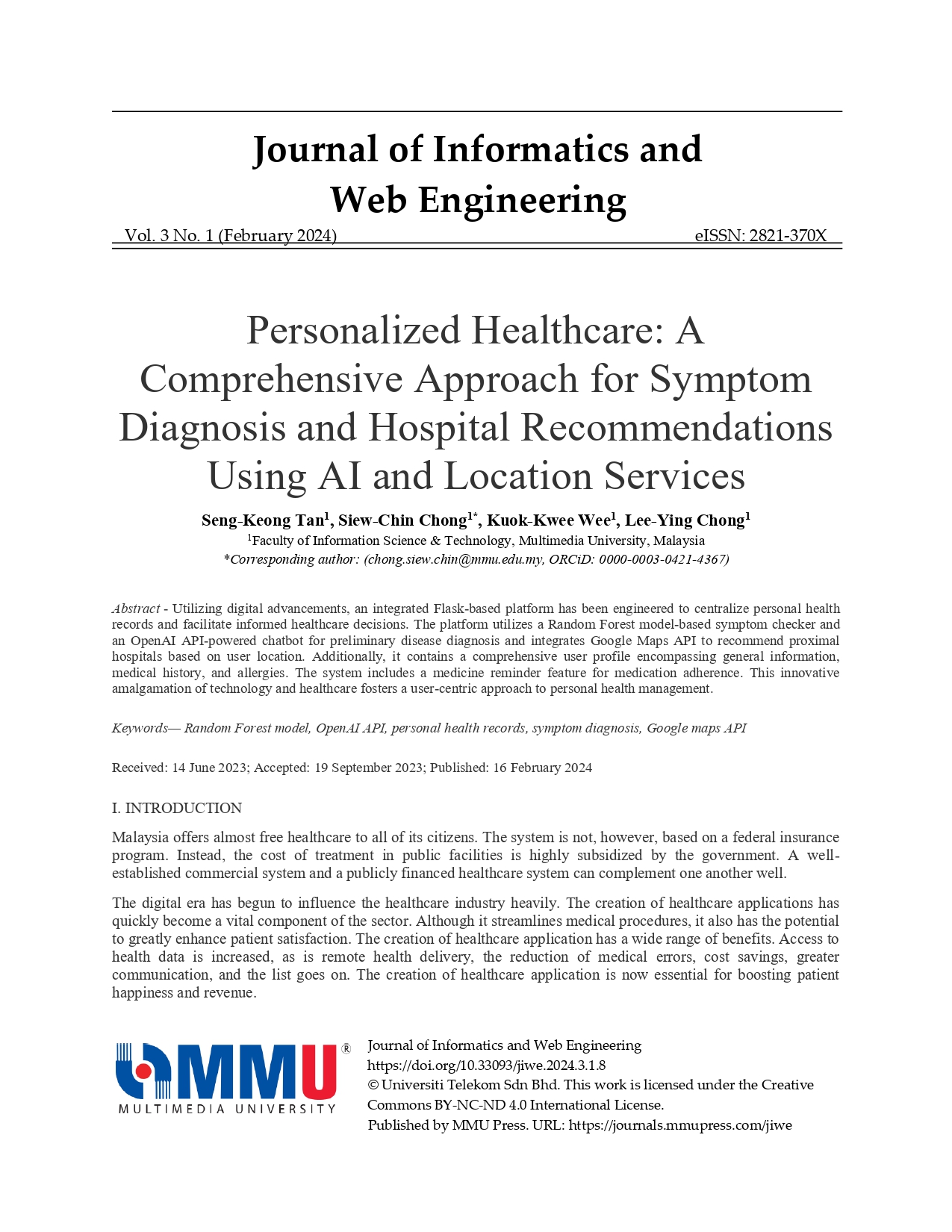Personalized Healthcare: A Comprehensive Approach for Symptom Diagnosis and Hospital Recommendations Using AI and Location Services
Main Article Content
Abstract
Utilizing digital advancements, an integrated Flask-based platform has been engineered to centralize personal health records and facilitate informed healthcare decisions. The platform utilizes a Random Forest model-based symptom checker and an OpenAI API-powered chatbot for preliminary disease diagnosis and integrates Google Maps API to recommend proximal hospitals based on user location. Additionally, it contains a comprehensive user profile encompassing general information, medical history, and allergies. The system includes a medicine reminder feature for medication adherence. This innovative amalgamation of technology and healthcare fosters a user-centric approach to personal health management.
Article Details

This work is licensed under a Creative Commons Attribution-NonCommercial-NoDerivatives 4.0 International License.
All articles published in JIWE are licensed under a Creative Commons Attribution-NonCommercial-NoDerivatives 4.0 International (CC BY-NC-ND 4.0) License. Readers are allowed to
- Share — copy and redistribute the material in any medium or format under the following conditions:
- Attribution — You must give appropriate credit, provide a link to the license, and indicate if changes were made. You may do so in any reasonable manner, but not in any way that suggests the licensor endorses you or your use;
- NonCommercial — You may not use the material for commercial purposes;
- NoDerivatives — If you remix, transform, or build upon the material, you may not distribute the modified material.
References
R. Kannan, I. S. Rosdi, K. Ramakrishnan, H. R. Abdul Rasid, M. H. L. Mohamed Rafy, S. Yusuf & S. N. A. Mohd Salamun, “Leveraging Business Data Analytics and Machine Learning Techniques for Competitive Advantage: Case Study Evidence from Small Businesses”, International Journal of Management, Finance and Accounting, vol. 2, no. 1, pp. 73–87, 2021.
L. Kaboutari-Zadeh, A. Azizi, A. Ghorbani & A. Azizi, “Designing and evaluating a mobile personal health record application for kidney transplant patients”, Informatics in Medicine Unlocked, vol. 30, 2022.
C. N. Villavicencio, J. J. Macrohon, X. A. Inbaraj, J. H. Jeng & J. G. Hsieh, “Development of a Machine Learning Based Web Application for Early Diagnosis of COVID-19 Based on Symptoms”, Diagnostics, vol. 12, no. 4, pp. 1 – 30, 2022.
P. L. T. Irawan, C. B. S. Hartanto & O. H. Kelana, “Medicine Consumption Reminder and Monitoring Application for Patients with Leprosy Disease”, Journal of Community Practice and Social Welfare, vol. 2, no. 1, 2022.
R. Wahdiniwaty, E. B. Setiawan, F. Auliardi & D. A. Wahab, “Application Model for Travel Recommendations Based on Android”, IJNMT (International Journal of New Media Technology), vol. 6, no. 1, 2019.
WebMD, WebMD Symptom Checker, WebMD LLC, https://symptoms.webmd.com/ (accessed April 4, 2023)
Symptoma, Welcome to Symptoma. Symptoma, GmbH, https://www.symptoma.com/ (accessed January 11, 2023)
OpenEMR. Fully Working OpenEMR 7.0.1 Demo, OpenEMR Foundation, Inc., https://www.open-emr.org/demo/ (accessed May 3, 2023)
Medisafe, Medisafe Pill & Med Reminder. MedisafeApp, https://play.google.com/store/apps/details?id=com.medisafe.android.client&hl=en&gl=US&pli=1 (accessed January 15, 2023)
Getdoc, GetDoc - Search and Appointmen. Jireh Group, https://play.google.com/store/apps/details?id=com.jireh.goseedoc&hl=en&gl=US (accessed February 5, 2023)
J. de V. Mohino, J. B. Higuera, J. R. B. Higuera, & J. A. S. Montalvo, “The application of a new secure software development life cycle (S-SDLC) with agile methodologies”, Electronics (Switzerland), vol. 8, no. 11, pp. 1 – 28, 2019.
A. A. Akimov, D. R. Valitov & A. I. Kubryak, “Data Preprocessing for Machine Learning”, Scientific Review. Technical Sciences, no. 2, 2022.
R. Meenal, P. A. Michael, D. Pamela & E. Rajasekaran, “Weather prediction using random forest machine learning model”, Indonesian Journal of Electrical Engineering and Computer Science, vol. 22, no. 2, pp1208-1215, 2021.
Kaggle. Disease Prediction Using Machine Learning. Kaggle Inc., https://www.kaggle.com/datasets/kaushil268/disease-prediction-using-machine-learning (accessed December 15, 2022)
S.T. Lim, J.Y. Yuan, K.W. Khaw & X. Chew, “Predicting Travel Insurance Purchases in an Insurance Firm through Machine Learning Methods after COVID-19”, Journal of Informatics and Web Engineering, vol. 2, no. 2, pp. 43 – 58, 2023.

